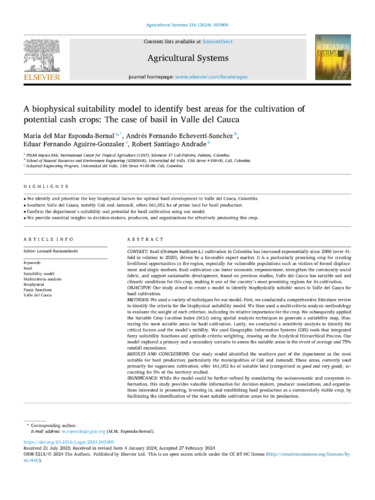A biophysical suitability model to identify best areas for the cultivation of potential cash crops: The case of basil in Valle del Cauca
CONTEXT
Basil (Ocimum basilicum L.) cultivation in Colombia has increased exponentially since 2006 (over 41-fold in relation to 2020), driven by a favorable export market. It is a particularly promising crop for creating livelihood opportunities in the region, especially for vulnerable populations such as victims of forced displacement and single mothers. Basil cultivation can foster economic empowerment, strengthen the community social fabric, and support sustainable development. Based on previous studies, Valle del Cauca has suitable soil and climatic conditions for this crop, making it one of the country's most promising regions for its cultivation.
OBJECTIVE
Our study aimed to create a model to identify biophysically suitable zones in Valle del Cauca for basil cultivation.
METHODS
We used a variety of techniques for our model. First, we conducted a comprehensive literature review to identify the criteria for the biophysical suitability model. We then used a multi-criteria analysis methodology to evaluate the weight of each criterion, indicating its relative importance for the crop. We subsequently applied the Suitable Crop Location Index (SCLI) using spatial analysis techniques to generate a suitability map, illustrating the most suitable areas for basil cultivation. Lastly, we conducted a sensitivity analysis to identify the critical factors and the model's stability. We used Geographic Information Systems (GIS) tools that integrated fuzzy suitability functions and aptitude criteria weighting, drawing on the Analytical Hierarchical Process. Our model explored a primary and a secondary scenario to assess the suitable areas in the event of average and 75% rainfall exceedance.
RESULTS AND CONCLUSIONS
Our study model identified the southern part of the department as the most suitable for basil production, particularly the municipalities of Cali and Jamundí. These areas, currently used primarily for sugarcane cultivation, offer 161,052 ha of suitable land (categorized as good and very good), accounting for 5% of the territory studied.
SIGNIFICANCE
While the model could be further refined by considering the socioeconomic and ecosystem information, this study provides valuable information for decision-makers, producer associations, and organizations interested in promoting, investing in, and establishing basil production as a commercially viable crop, by facilitating the identification of the most suitable cultivation areas for its production.

